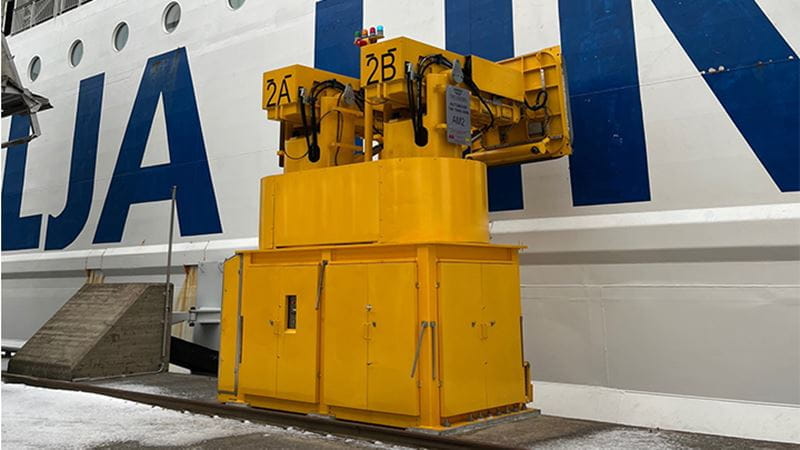Trelleborg supplies Automated Mooring System to Port of Langnas

Trelleborg Marine and Infrastructure has supplied its rope-free automated mooring system, AutoMoor, to the Port of Langnas’ international cruise ferry and domestic Ro-Ro ferry terminals. The Port of Langnas is situated in the Baltic Sea on the archipelago of Aland, which has intensive ferry traffic between Sweden and Finland via Aland.
Using vacuum technology to rapidly attach and secure a vessel at berth, AutoMoor reduces vessel motions and continuously monitors all mooring loads acting on the vessel at berth. This provides live data to the operator to optimize day-to-day port and terminal operations. AutoMoor also minimizes personnel involvement, reducing human error and improving safety, while helping ports and terminals become more environmentally efficient. Once a vessel is moored – which takes less than a minute – AutoMoor operates in a power efficiency mode, using minimal power to monitor mooring forces while the vessel is at berth.
Richard Hepworth, President of Trelleborg Marine and Infrastructure, says: “The port industry continually faces the challenge of maximizing berth utilization to allow product or passenger transfers to occur as seamlessly as possible with minimal downtime. Automating the mooring process is vital in optimizing the vessel turnaround process and improving port safety, efficiency and sustainability. We’re delighted to be able to facilitate exactly that for the Port of Langnas, which services over 3,000 ship arrivals annually.”
Trelleborg conducted a thorough analysis to determine the optimum locations to mount the six T40 Twin Arm AutoMoor units along the berth. The required analysis took into consideration the available space on the hull of each vessel – avoiding ports, doors and protrusions – for the vacuum pads to attach.
Ronny Eriksson, CEO at the Port of Langnas, commented: “The port’s international cruise ferry berth has a significantly high vessel throughput, accommodating some of the most technologically advanced cruise ferries worldwide. In order to facilitate quick, safe and reliable mooring operations, we are delighted that Trelleborg has provided six of its T40 Twin Arm AutoMoor units. This will allow the mooring of as many as seven different RoPax vessels up to 223 meters in length and over 65,000 tonnes in weight, enroute between Sweden and Finland.”
“Trelleborg also supplied two of its AutoMoor T40 Twin Arm units to support the port’s domestic operations by successfully mooring the 108-meter long Fjardvagen, a RoRo vessel that travels daily between Langnas and Naantali, mainland Finland,” added Eriksson.
Trelleborg’s AutoMoor T40 Twin Arm has two mooring arms that can operate in synch or independently to provide flexible mooring of vessels with varying hull profiles. The arms can be pre-set to attach to vessel hulls at different heights to avoid obstacles on the hulls and optimize the mooring arrangement and enable the port to accept a greater range of vessel types. The AutoMoor T40 Twin Arm also has a compact footprint allowing for installation in limited spaces including between gantry rails and the wharf edge.
AutoMoor solution falls within the SmartPort portfolio of Trelleborg Marine and Infrastructure. SmartPort powers the critical interface between ship and port, on land and at sea. It connects port operations, allowing operators to analyze performance and use data to improve decision making. The system integrates assets like fenders, mooring equipment, ship performance monitoring, and navigation systems, underpinned by cloud and Internet of Things (IoT) technologies.